An eerie creek echoes as a pair of eyes slowly open piercing through the dark. The whites of the eyes slowly move towards you sitting motionlessly. Shrouded in darkness, the owner of the eyes exclaims excitedly he hasn’t had a new challenger in ages. The menacing eyes explain a card game that requires you to make horrific sacrifices. Try as you might, you don’t make it very far. The looming pair of eyes instructs you to get up from the table and fetch the candlestick. You take a glance around the dim cabin as the sound of rain gently taps on the roof. You return to the table as instructed. Your mysterious game master only lights one of the two candles. He scornfully warns that another mistake and he will snuff out the other candle and your life. You continue to try and balance having enough creatures to fight and make sacrifices with. Unfortunately, the onslaught becomes too much and the final candle goes out. Final words of disappointment are given as a grizzly pair of hands reach across the table for your neck.
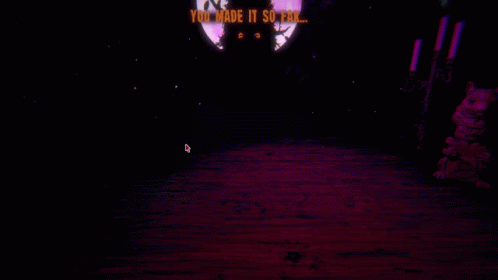
Welcome to Inscryption.
This opening moment was enough for Daniel Mullen’s latest game, Inscryption, to sink its teeth into me. It is no secret that horror is one of my favorite genres. Whether it be the unsettling words of H.P. Lovecraft or the spine-tingling moments in Alien, hearing my heart pound as fear consumes me has always felt exhilarating. Video games push that extreme even further. It is one thing to watch Ellen Ripley wander around the cramped tunnel with a predatory monster on the loose, but games force you to take that step down those tunnels. Inscryption is able to capture an indistinguishable atmosphere of dread similar to a movie like Pet Cemetry. There is are no jump scares like Resident Evil or Dead Space titles, but the uneasy nature of sacrificing critters in a dark cabin is enough to raise the hair on the back of your neck. Impressive considering you’re still just playing a card game.
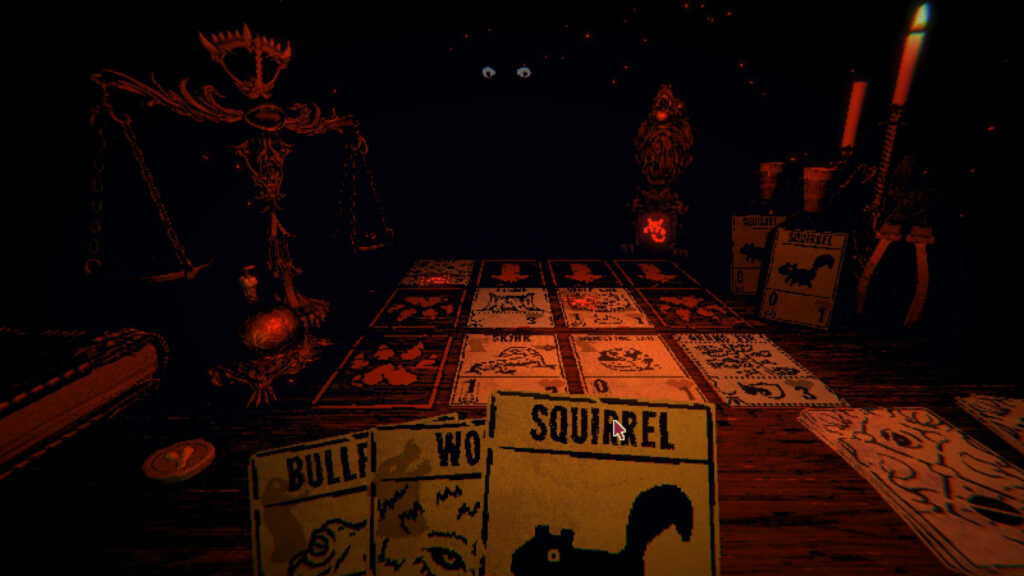
Card games are another genre I have grown to love over the years. Likely due to years of Hearthstone to offset my World of Warcraft addiction. Surprisingly, the card game within Inscryption seems simple on the surface but soon you learn the dizzying depth within it. Simply sacrifice smaller creatures to be able to summon bigger and tougher creatures. At the beginning of your turn, you can draw from your deck or draw a squirrel that has one health and no attack to your hand, but he’s also free to play. You can place him on the board and then use him to pay for the Stoat card in your hand that has three health, one attack, and costs one creature sacrifice (one blood) to play. On your next turn, you can choose to keep the Stoat on the board or sacrifice the Stoat and more squirrels to summon something bigger, creating a lot of tough decisions. Decisions get tougher with bone tokens. You can earn a bone token whenever one of your creatures dies for any reason. You’ll often find yourself debating whether to draw a squirrel that you could use on a later turn or gamble hoping you’ll draw a creature that costs bones. Often I sat there at the beginning of my turn trying to calculate the safer draw adding to the chilling atmosphere surrounding Inscryption.
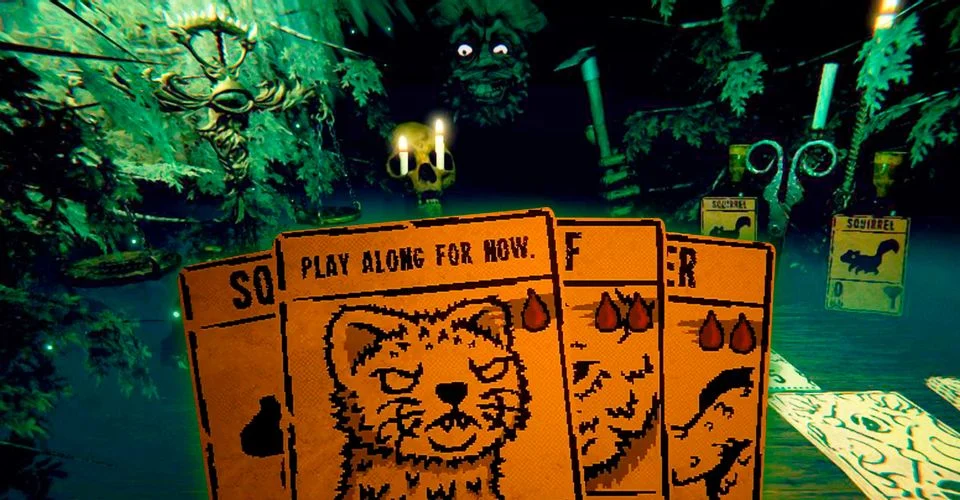
Your creature will attack the card in front of them on the board, doing permanent damage to opposing creatures or damage to the mysterious game master if he has no creatures in front of him. Damage done to both you and him is tracked on a scale, and one simply wins a match by tipping the scale towards your opponent. The scale tips towards the game master and your piece will move along a game board the game master brings out between matches. The scale tips towards you and well you know how that ends.
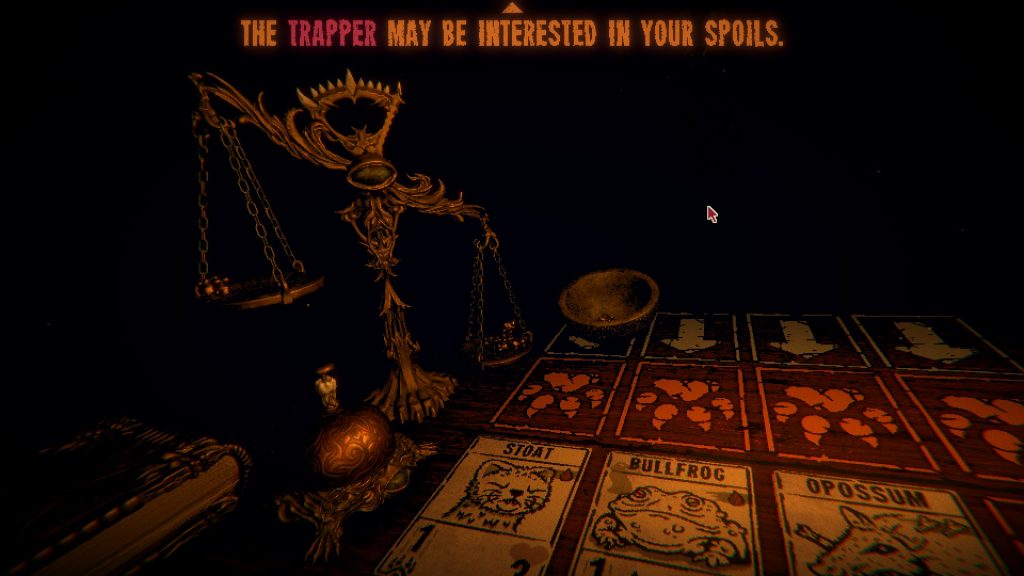
The game board will act similar to a path in a game of Dungeons and Dragons. As you approach a new area, the mysterious game master will narrate the new area with the gusto of an excited dungeon master. The path on the board tends to stay linear, but it will frequently splinter into multiple paths, giving you a choice; you must choose carefully. Not only can paths lead you into dangerous encounters, but they will also often give you the opportunity to give you items to cheat, and you need all the help you can get. Regular encounters, totem encounters, and boss fights will catch you off guard if you are not prepared. My victory in Inscryption was only possible because a character called the Wood Carver gave me a totem that made it so when I sacrificed a squirrel it allowed me to summon creatures that cost three bloods. The other time I won because I was able to use campfires and sacrifice stones to power up a card called the Mantis God that strikes in three directions.
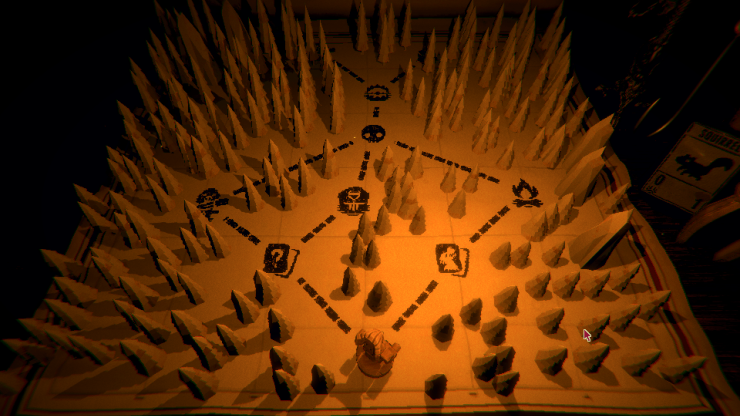
As you play more of Inscryption, you will find a narrative that, similar to the card mechanics, has more lurking beneath the surface. That Stoat card I mentioned, calls you out for sacrificing him while he was napping. He claims to be trapped within the card and can feel pain when he is sacrificed. He urges you to locate his allies who are cards scattered around the cabin. With the ability to get up from the table in between rounds, you are able to fiddle with puzzles with the cabin very much like an escape room. So Inscryption is a horror-themed card game within an escape room game. It all seems like too much, but Inscryption weaves it all together in an almost Cabin in the Woods level. From the eerie backdrop to the bigger narrative looming under the service, I could help but think of the 2011 film as I was able to best the game master at their own game.
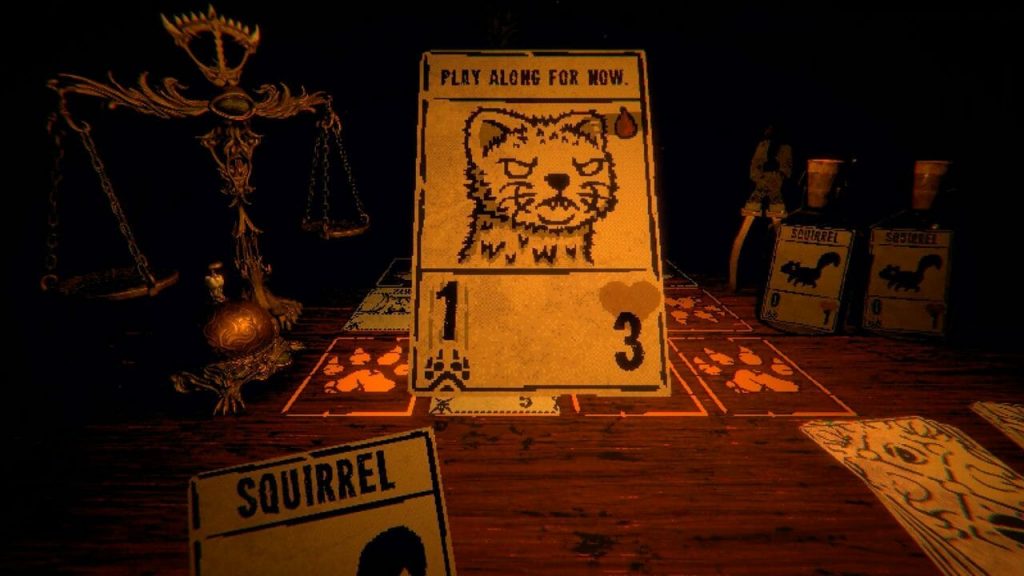
Unfortunately, Inscryption is not all dark cabins and the ominous glare of the game master. The game’s eerie atmosphere all but vanishes as it transitions to its second act. I will do my best not to spoil anything, but if you have played any of Daniel Mullen’s previous work, you know he loves to switch up a game’s genre partway through the game. Inscryption certainly doesn’t buck this trend, but it doesn’t exactly feel warranted here. In a game like The Hex, the narrative revolves around characters from a variety of different games; it would make sense to be platforming with a cartoon mascot and playing a turn-based RPG with a wizard. However, the opening act of Inscryption hooked me so well, that I was frustrated by the shift in tone. The narrative does eventually explain the sudden shift, but Inscryption shifts to a genre that I was not as excited about as I was with my cabin in the woods. It still remains a card game, but the escape room cabin is changed to a genre that, frankly, feels like it leans too heavily on nostalgia. The game during act two looks like a million other games that you can find among Steam; very few games have the atmosphere that was crafted in the first act.
To make matters worse, the game introduces the third and fourth card mechanic during this act. Inscryption will present you with a choice of a new deck that either revolves around the blood, bones, third or fourth mechanic. Foolishly, I decided to take a new deck that revolved around the fourth mechanic: gems. A system that required me to have certain gems on the field in order to play more powerful cards. The system seemed easy on paper but soon became difficult and overwhelming as cards that had gems were typically very weak cards. I certainly appreciated the shift in gameplay, but I eventually returned to the blood and bones mechanics from the previous act. Thankfully, the third and final act does a better job teaching these mechanics and I did grow to appreciate the gems systems. However, the lack of direction on this new system, in the second act, increased my frustration with the out-of-left-field change to the game.
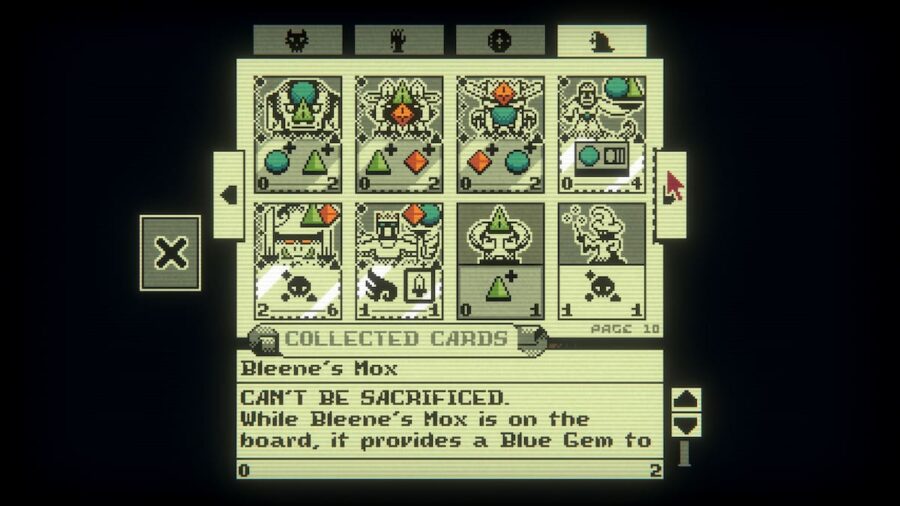
You will eventually reach the third act of the game which returns to a similar table-top escape room similar to the first act. However, rather than be a roguelike, the game turns into a Dark Soul-style RPG. You move around a map similar to the map in act two, but you activate checkpoints where you respawn when you lose a battle. You also drop part of your money when you died, but in traditional Souls fashion, you can retrieve that bountiful loot by returning to the spot where you died. This act also completely revolves around the Energy and Gems mechanics, but thankfully this act explains the two systems and how they can work together. You gain more energy per turn and should use these energy-based cards to protect the weaker gem cards that are required to summon more powerful cards. After a few rounds, I was able to craft a deck that weaves the two mechanics skillfully. I sincerely enjoyed this final act much more than the second act, but I still missed the dark and dreary cabin in the first act.
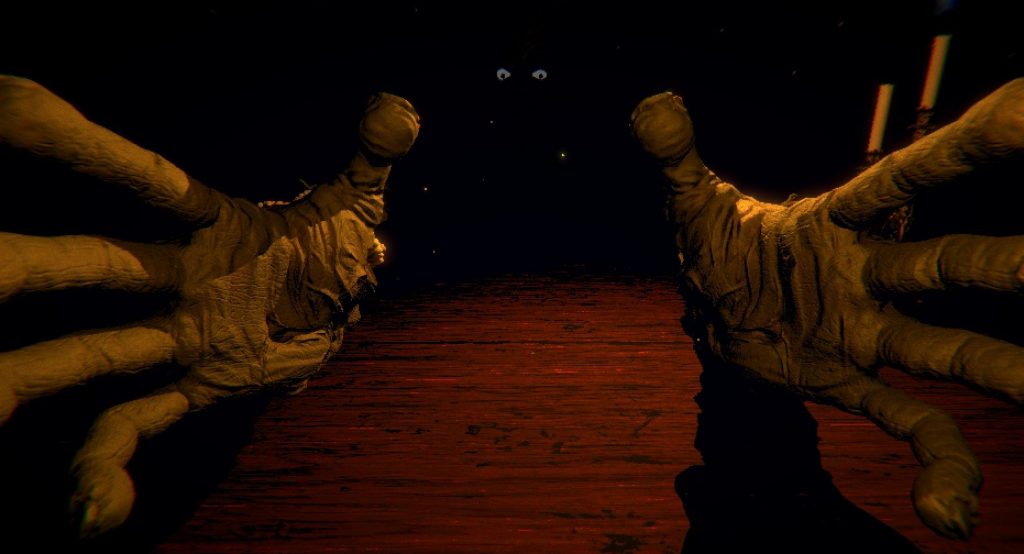
Fortunately for me, Daniel Mullins answered my prayers. A mini-expansion known as Kaycee’s Mod was added to the game. The mod is an endless mode of the first act. I could be locked in that creepy cabin playing cards with an eerie pair of eyes until the end of days. On top of filling my delights of horrors and card games, the mod adds additional challenges you can use to unlock more horrific cards. However, don’t be fooled, some of these challenges are daunting: fewer items in your pack, the cost of pelts increase, and no option to re-roll cards when you have to pick cards. This mod has thoroughly tested my card playing skills and I have only tasted victory once. However, I find the atmosphere so arresting, that I continuously return to the game to ram my head against that wall. In the ways, people have gotten hooked on Hades, Dead Cells, or Binding of Issac, the roguelike nature of Inscryption has completely gripped me.
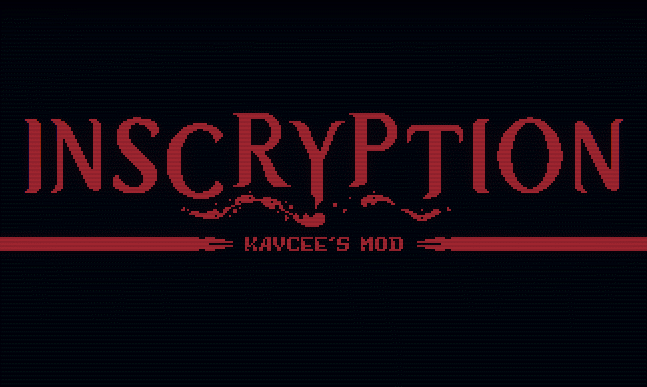
There is a moment in Inscryption where one of the characters describes the game master within act one as sloppy. They claim he cared more about lore and flavor than the actual card mechanics. That comment certainly rattled in the back of my mind as I continue to play round after round of Kaycee’s mod. I certainly appreciate the four various styles of play within Inscryption. It’s the atmosphere that keeps drawing me to that dark cabin. I will never get over that sense of chill in the air all stemming from a card game. So while others choose different roguelikes, card games, or even other roguelike card games, I will continue to travel deep into the wood to that ominous cabin to play more rounds of Inscryption.
